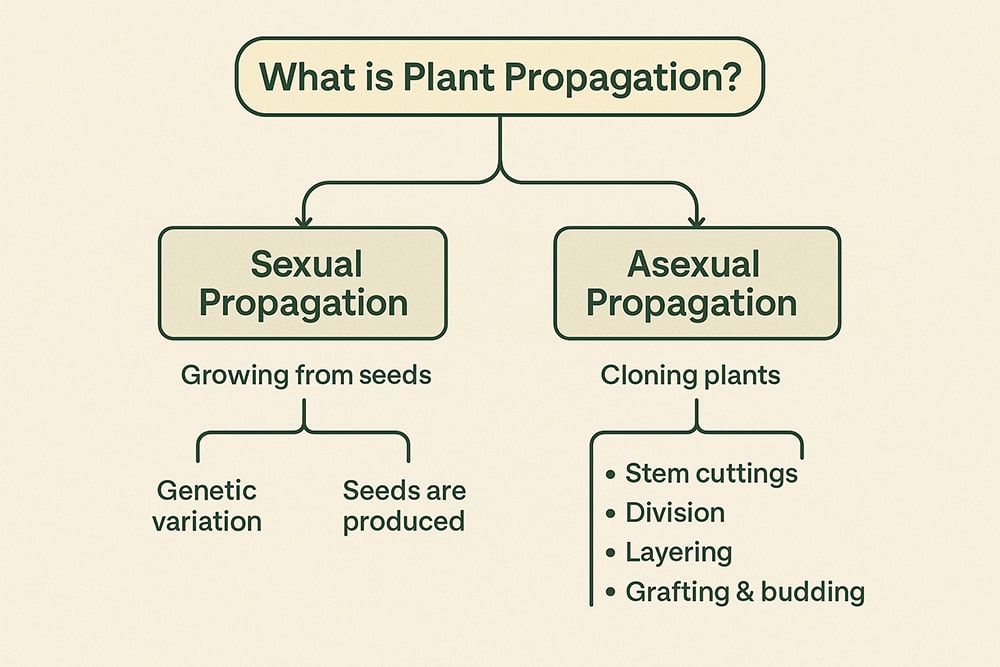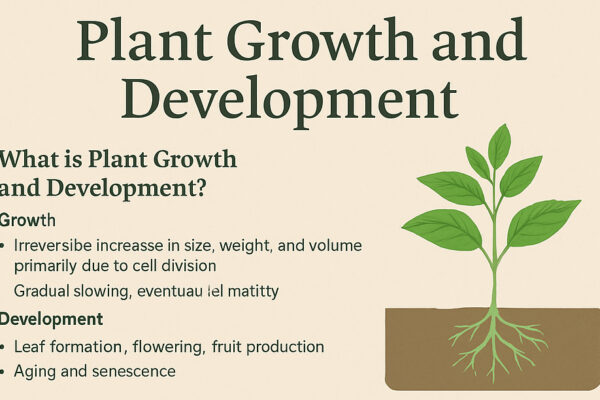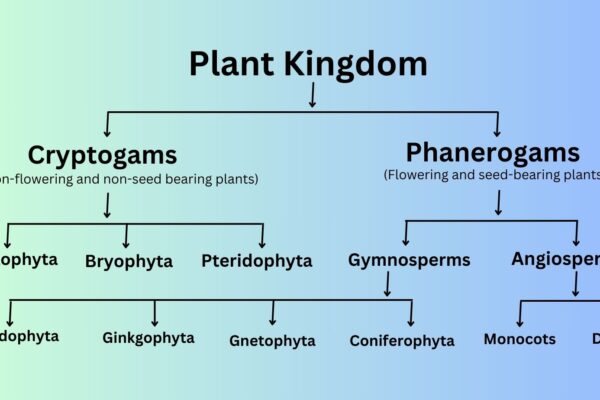Plant propagation is the process of creating new plants from the ones you already have. It’s one of the most rewarding and cost-effective skills a gardener can learn. Whether you’re planting seeds or rooting a cutting from a favorite shrub, propagation gives you a way to grow more while spending less.
It also helps you preserve special plants, expand what’s thriving in your space, and share your success with others. Once you learn a few techniques, every healthy plant becomes a chance to grow something new.
There are two main types of plant propagation: sexual and asexual. Sexual propagation involves seeds and encourages natural variation, while asexual methods—like cuttings and division—produce clones of the original plant. Both have a valuable role in the garden.
What is Plant Propagation?
Plant propagation is the process of growing new plants from seeds, cuttings, roots, or other plant parts. In nature, it happens constantly—plants drop seeds, send out runners, or produce new shoots from their base. Gardeners simply take this natural process and guide it to multiply the plants they want.
Propagation can occur with or without human help. For example, a tomato plant that drops seeds and sprouts new ones the following year is self-propagating. But when a gardener takes a rosemary cutting and roots it in water, that’s assisted propagation. Both methods create new plants—the difference is how much control you have over the process.
Understanding propagation gives gardeners a clear advantage. It allows you to expand your garden, maintain rare or special varieties, and better understand how plants grow, reproduce, and adapt.

Two Main Types of Plant Propagation
All propagation methods fall into two broad categories: sexual and asexual propagation. Knowing the difference helps you choose the best approach depending on the plant and your gardening goals.
Some gardeners value variety and adaptability, while others want consistency and predictability. Some plants grow easily from seed, while others require more hands-on methods. That’s where understanding these two types becomes essential.
Sexual Propagation (Growing from Seeds)
Sexual propagation is the process of growing plants from seeds. Seeds form when pollen from one flower fertilizes the ovule of another, resulting in a plant with a unique genetic makeup. This is how most plants reproduce in nature, and it’s a time-tested method gardeners have used for centuries.
One of the biggest advantages of seed propagation is genetic diversity. Because each seed is genetically distinct, plants grown from them may develop slightly different traits. This natural variation can lead to stronger, more adaptable plants over time.
According to the University of Florida IFAS Extension, sexual propagation introduces variation that can improve disease resistance and environmental adaptability in plant populations.
(Source: UF/IFAS Plant Propagation)
Seed propagation is also budget-friendly. A single packet can produce dozens of plants, and many species—such as tomatoes, calendula, and cilantro—readily reseed themselves in the garden.
However, it’s not always predictable. Seeds collected from hybrid plants might not produce offspring with the same qualities. Others can be stubborn—some need special steps, like chilling or nicking the seed coat, just to get started. And even when conditions are right, germination can still take a long time.
When to use sexual propagation:
- Starting vegetables, herbs, and annual flowers
- When you want variety and adaptability
- Growing large numbers of plants on a budget
- Saving and replanting seeds from open-pollinated or heirloom plants
Asexual Propagation (Cloning Plants)
Asexual propagation, also known as vegetative propagation, involves reproducing plants using parts of the parent plant—such as stems, roots, or leaves. Unlike growing from seed, these methods produce clones, meaning the new plants are genetically identical to the original.
This technique is ideal when you want to preserve specific characteristics, such as flower color, fruit size, or resistance to pests and diseases. Asexual propagation is commonly used for houseplants, perennials, shrubs, and fruit trees—especially those that don’t grow reliably from seed.
There are several methods of asexual propagation, including:
- Stem cuttings: A section of stem is cut and rooted in soil or water.
- Division: A mature plant is split into smaller, rooted parts.
- Layering: A flexible branch is bent to the ground to root while still attached to the parent.
- Grafting and budding: Parts of two plants are joined to grow as one.
The biggest benefit is uniformity. If you have a plant that performs exceptionally well, you can reproduce it exactly—same flowers, same growth habits, same overall success. It’s also often faster than growing from seed, particularly for slow or finicky plants.
But there’s a trade-off. Clones lack genetic diversity, which means if one plant is vulnerable to disease, all its copies likely will be too. And without variation, these plants may struggle to adapt to changing environmental conditions.
When to use asexual propagation:
- Propagating houseplants, perennials, or woody shrubs
- Multiplying a plant with specific traits you want to preserve
- Speeding up reproduction of slow-growing or hard-to-seed plants
- Growing plants that don’t produce viable or consistent seeds
Most gardeners use a blend of both methods—sowing annuals from seed in spring, dividing perennials in fall, or rooting herb cuttings during summer. Learning how and when to use each technique gives you more flexibility, better results, and a stronger connection to your garden.
Further Reading: Classification of Plants
Why Propagation is Useful in the Garden
Learning to propagate your own plants changes how you approach gardening. You begin to see every healthy shoot or leaf as an opportunity. You grow more from what you already have. And you build a deeper, more rewarding relationship with the plants in your care.
Propagation is practical. It helps you create new plants easily and often for free. Whether you’re growing vegetables, herbs, flowers, or shrubs, propagation gives you more control over what thrives in your space.
Here’s why gardeners turn to propagation:
- Save money: Turn one plant into many instead of buying new ones.
- Preserve favorites: Keep heirloom or rare plants going for years.
- Share the joy: Gift rooted cuttings or divided plants to friends and neighbors.
- Reduce waste: Reuse pruned stems and cuttings instead of discarding them.
- Build a self-sustaining garden: Let your garden renew itself naturally.
- Experiment and learn: Test different methods and grow your skills.
- Support biodiversity: Propagate native and pollinator-friendly plants.
- Tailor your garden: Expand only what thrives in your soil and climate.
Over time, propagation becomes more than just a technique—it becomes a mindset. You’ll make fewer trips to the nursery, spend less, and grow more with what you already have. It’s a skill that empowers gardeners and helps every plant thrive with purpose.
Common Methods of Asexual Propagation
Asexual propagation allows you to create new plants that are exact copies of the original. It’s a simple, effective way to multiply your favorites, preserve plant traits, and grow more in less time than starting from seed. Each method uses a different part of the plant—stem, leaf, or root—to generate new growth.
Here are the most common and beginner-friendly techniques:
1. Stem Cuttings
This is one of the easiest and most popular methods for home gardeners. Take a healthy 4–6 inch stem cutting, remove the lower leaves, and place it in soil or water until roots form. Many soft-stemmed plants root quickly and have a high success rate.
Herbs like basil and mint, houseplants like pothos and coleus, and shrubs such as hydrangeas all respond well to this method.
The Royal Horticultural Society notes that softwood cuttings root quickly and are widely used for herbs, shrubs, and flowering plants.
(Source: RHS – Propagation by Cuttings)
2. Leaf Cuttings
Some plants can grow entirely new roots and shoots from a single leaf or a section of one. This method works especially well with plants that store energy in their leaves, like succulents and African violets.
To propagate, place the leaf flat on top of the soil or insert its base into the soil, depending on the species. In time, new roots will form, followed by small shoots. It’s a simple and fun way to expand your houseplant collection.
3. Root Division
Root division involves digging up a mature plant and separating it into smaller sections, each with roots and shoots attached. It’s most commonly used for clump-forming perennials such as hostas, daylilies, ornamental grasses, and herbs like chives.
Division is typically done in early spring or fall. It not only produces new plants but also revitalizes the parent by reducing overcrowding and encouraging fresh growth.
4. Layering
Layering allows a stem to form roots while it’s still attached to the parent plant. Once the stem has rooted, you can cut it off and plant it as a new individual.
This method works well with flexible, low-growing shrubs and vines like rosemary, strawberries, and blackberries. To try it, bend a healthy branch to the ground, cover a portion with soil, and secure it with a small stone or garden pin. Roots usually develop in a few weeks.
5. Grafting and Budding
These are advanced techniques where parts of two plants are joined to grow as one. Grafting is widely used with fruit trees, roses, and ornamental shrubs to combine desirable traits—such as strong root systems with superior flowering or fruiting.
Budding is similar, but instead of a stem or branch, a single bud is grafted onto the rootstock. While these methods require skill and practice, they’re essential for propagating many commercial varieties and for gardeners who want to take their skills to the next level.
Each of these propagation techniques serves a unique purpose. Some are fast and simple—perfect for herbs and houseplants. Others are more involved but offer big rewards, especially for fruit trees or woody shrubs.
Once you understand how and when to use each method, you’ll be able to multiply your garden with confidence, creativity, and care.


